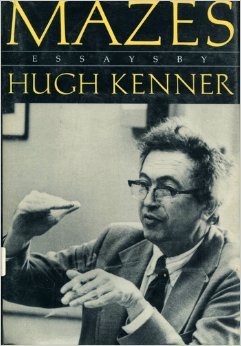Hugh Kenner, by day an unassuming professor of English literature at the Johns Hopkins University, is our foremost practitioner of the ancient cult of the maze, a celebrant of this endless labyrinth in which we live. Confronted with its mysteries, Mr. Kenner, the new Theseus, confidently draws on a lively knowledge of science, technology, music, architecture, language, art, politics, and literature to explain the way to comprehension. For three decades, it has been the pleasure of readers to watch his mind at work in a number of important, even revolutionary books, among them The Pound Era, a history of literary modernism, and Bucky, a critical inquiry into the life and work of Buckminster Fuller, who, to continue the metaphor, is our century’s Hephaestus.
At the heart of Hugh Kenner’s method, displayed throughout the pages of his new, aptly titled collection of essays, rests the doctrine that the truth—or such truth as there is—emerges from the intersection of reverberant facts. This intersection, he suggests, alone has explanatory power. In casually linked essays on the relevance of the study of scientific history to that of literature, for example, Mr. Kenner asks us to consider these encyclopedic details:
—Alexander Graham Bell had no telephone in his home, believing his invention to be appropriate only to commerce. Twenty years later, almost all the characters in James Joyce’s Ulysses are seen to have private telephones. (This two-decade gestation period, he might have added, also characterizes the growth of the computer industry.)
—Thanks to Albert Einstein and his principle of Time Dilation, we now understand that there is no universal time. The medium truly is the message.
—Mandelbrot functions, the basis of fractal geometry, demonstrate once and for all that ontogeny recapitulates phylogeny. And the inventor’s name means “almond bread” in Yiddish. The almond tree was sacred in ancient Rome.
—William Shakespeare’s vocabulary comprised some 29,000 words; a complete modern English lexicon numbers more than a million. T.S. Eliot’s poem “The Hollow Men” relies on 417 words, 187 different ones, a mere 65 of which constitute three-quarters of the poem.
These are radiant details, gathered by a lifetime’s exploration and tinkering, actions that underlie so-called “cultural literacy.” Kenner, not drawing undue attention to his cleverness in having ferreted out such facts, is quick to point out that in themselves they contain no great truths; singly, they are only curiosities. But draw such oddments together, Kenner instructs, and you have the thread leading through the labyrinth of the world. “The great encyclopedic minds of antiquity—Aristotle, Cicero, Confucius—wouldn’t have known what a fact was,” he writes. “They beheld a kaleidoscope of interacting principles in which no event stays still long enough to have its tail salted. . . . [knowledge] might entail the study of virtually everything.”
And so Mazes touches on virtually everything. In the fifty pieces that make up the book, Kenner writes variously of the higher mathematics, evolutionary theory, the physical discomforts produced by modern book design, economics, movies, museums, the relative chaos or order of one’s writing table, climatology, lexicography, linguistics, the state of copy editing in commercial publishing, the accomplishments of friends and mentors, interior design, electoral politics (“we’re governed by caricatures,” he writes, “because we perceive by them”), electronics, chess, the decline of apprenticeship in Georgian England. Taking his title to heart, Kenner even offers an illuminating piece on how to escape from a maze, a useful string of information to memorize before venturing into any labyrinth—London’s Hampton Court, let us say, or a new piece of software.
Kenner invites comparison with Michel de Montaigne; his diverting articles are essays, “attempts,” in exactly the sense that Montaigne, who invented the modern form, intended. They are joyful trials of discovery, and they are almost always successful, although Mr. Kenner’s enthusiasms are sometimes misguided. Like many others, he makes a cult figure of Henry David Thoreau, who, remember, weekly compromised his legendary self-sufficiency by taking his wash home to his mother. Ever the champion of the modernists, Kenner can write with a straight face that T.S. Eliot “slaved” in a British bank, ignoring Eliot’s well-documented contentment with his work and embarrassment at his friends’ efforts to buy him away from his post. (In any event, can the work of a bank officer really be equated with that of a slave?) And Kenner’s essays in defense of Marshall McLuhan and Buckminster Fuller are much too easy, waving away justifiable criticisms against the work of these masters of self-promotion.
But imperfections accompany experimentation of any kind, and Kenner is not at all to be faulted for the rare slip. Part of the joy of negotiating a path through a thicket of details, after all, is in chasing up errors, in testing one’s own knowledge and opinions; Kenner’s sharp but good-natured essay on The Random House Encyclopedia offers a case in point. Mazes offers university-level instruction (and would that universities were as good) in a dozen disciplines, teaching as it delights. It is a pleasure to read, a fine addition to Hugh Kenner’s body of work, and a worthy monument to spirited intelligence and, not coincidentally, to that wonderful cult of the maze.
[Mazes, by Hugh Kenner (San Francisco: North Point Press) 336 pp., $22.95]

Leave a Reply